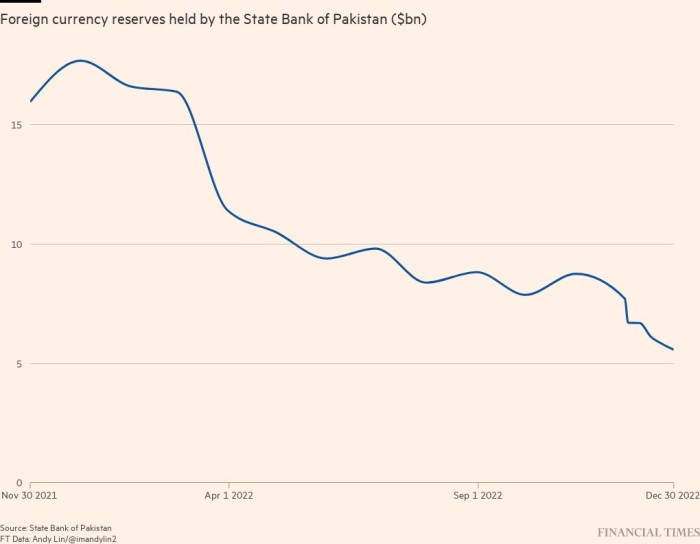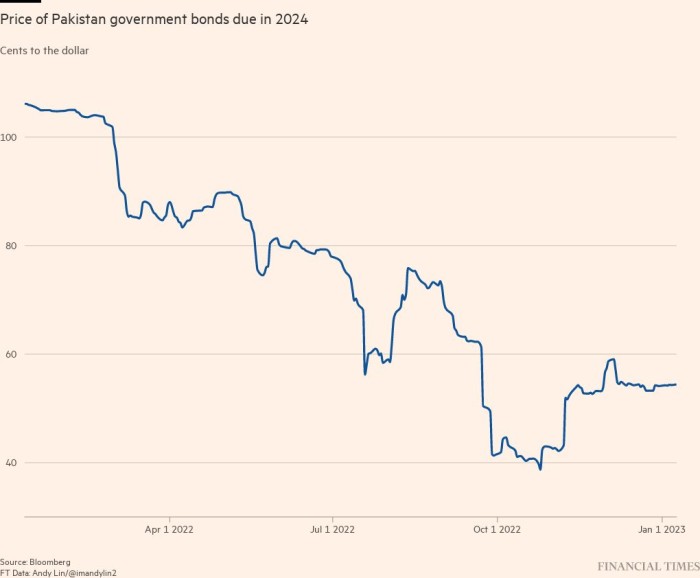[ad_1]
International lenders and governments have pledged more than $9bn to help Pakistan recover after catastrophic floods last year displaced tens of millions and hit the country’s already struggling economy, which is facing an energy crunch and dwindling foreign reserves.
After a donors’ conference in Geneva on Monday hosted by UN secretary-general António Guterres and Pakistan’s prime minister Shehbaz Sharif, Islamabad said it had lined up pledges of $4.2bn from the Islamic Development Bank, $2bn from the World Bank and $1bn from Saudi Arabia to help it rebuild from the floods, which affected more than 33mn people.
The calamity was the latest in a series of blows over the past year to hit Pakistan’s economy, which is already running short of cash, and has prompted the government to enforce cost-saving measures such as energy rationing and companies to slash production.
The US, EU, UK, China and Germany also promised aid on Monday in what Pakistan’s minister of information and broadcasting Marriyum Aurangzeb called a “generous outpouring” from the international community.
But Pakistan had estimated that it would need $16.3bn for flood relief, and the wider economic picture is even more desperate. The country’s foreign exchange reserves have dwindled to $5.6bn, down from $10bn in June and covering just one month’s worth of imports, according to official figures. In recent days, Pakistan’s media, without naming sources, have widely reported the number has fallen to $4.5bn after a $1.2bn repayment to United Arab Emirates banks.
Analysts said that while the aid would help Pakistan recover and adapt to climate change-related disasters, the funds would do little to alleviate the immediate cash crunch.
“The donor pledges . . . are specific and long-term and should go toward rebuilding the areas and lives devastated by the summer’s floods — not shoring up foreign reserves,” said Madiha Afzal, a fellow with the Brookings Institution in Washington. “Pakistan’s reserves have been at a precarious position since before the floods and are teetering at around one month’s imports again.”
Inflationary pressures, the fallout of Russia’s war in Ukraine and the floods have combined to create “perhaps the greatest economic challenge Pakistan has ever seen”, Afzal added.
Pakistan’s government has taken steps to protect limited resources, last week ordering shopping malls and markets to close by 8.30pm to conserve energy. Millat Tractors, Pakistan’s biggest farm machinery producer, shut down production, citing “reduced demand for tractors and cash flow constraints”. The State Bank of Pakistan has restricted companies’ access to letters of credit to conserve cash.
Imran Khan, the former prime minister ousted by parliament in 2022, has warned of the danger of default if Pakistan cannot secure additional financing from the IMF, which last year reauthorised a stalled $7bn assistance programme initially agreed in 2019.
But the lender has withheld the next $1.1bn tranche of support, as it pushes Islamabad to adopt austerity measures such as cutting spending and raising prices on subsidised gas and energy.
Ishaq Dar, Pakistan’s finance minister, has repeatedly dismissed the possibility that the country might default on its foreign debt. “Our foreign exchange reserves by end-June would be much better than you think,” he told journalists last week.
Dar met IMF officials on the sidelines of the donors’ conference, where they discussed “challenges to regional economies in the wake of climate change” and Pakistan’s finance minister “reiterated the commitment to complete the Fund programme”, according to a ministry statement.
Pakistan’s powerful new army chief General Syed Asim Munir is visiting Saudi Arabia, a historic lender to Islamabad in times of crisis. On Tuesday, Saudi state media reported that de facto ruler Crown Prince Mohammed bin Salman had called to consider raising investment in Pakistan’s economy to $10bn and the limit on deposits from the Gulf kingdom to the State Bank of Pakistan to $5bn.
“I think Pakistan will ultimately avoid default for now, largely through help from the IMF and loans from friendly countries like Saudi Arabia and China, but those won’t address the clear underlying malaise of the economy,” Afzal said.
Regional neighbour Sri Lanka, with debts totalling $51bn mostly owed to private lenders, stopped repaying its loans in May, becoming the first Asian country in decades to default.
Since Dar took over the finance ministry in September, Pakistan has managed the rupee-to-dollar exchange rate, which slowed the currency’s depreciation but damaged the real economy by making dollars badly needed by companies for their operations even more scarce.
“There’s undoubtedly a default risk, especially if the State Bank of Pakistan persists with unofficial currency pegging,” said Javed Hassan, founding chair of the Economic Advisory Group. “Even if that is removed and Pakistan concludes its IMF review successfully, default risk over the next six to 12 months will persist.”
Pakistan chronically spends beyond its means, analysts said, and thus relies heavily on foreign borrowing, leading to periodic crises and bailouts from the IMF and bilateral lenders led by Gulf countries and China. Pakistan’s total foreign debt and liabilities stands at about $100bn.
Mending ties with the IMF would pave the way for Pakistan to line up further financing from other bilateral lenders, keep servicing its debt and pay for energy this year.
However, Islamabad’s relations with the Washington-based multilateral lender were strained last month when Dar appeared to play down their importance. “I don’t care if they come,” the finance minister said, referring to the lender’s ninth review, which has not been completed. “I don’t have to plead before them.”
Acrimony between Sharif and Khan’s bitterly opposed political camps has exacerbated the economic crisis. Khan last week called for an early election and his Pakistan Tehreek-e-Insaf party warned of the dangers to the economy.
[ad_2]
Source link

